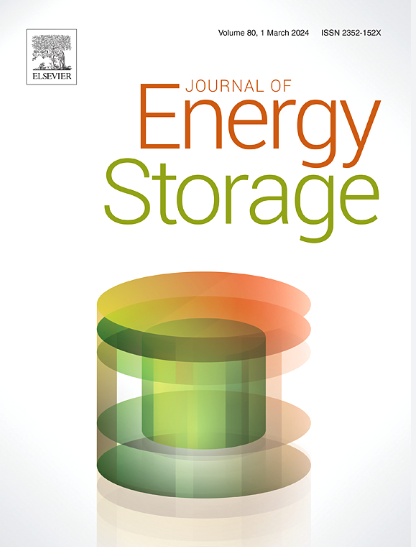核壳过渡金属二硫接枝碳基复合材料作为高性能锂离子电池的负极材料
IF 8.9
2区 工程技术
Q1 ENERGY & FUELS
引用次数: 0
摘要
从便携式电子产品到电动汽车,锂离子电池在广泛的应用中都是必不可少的。随着对高容量、长寿命电池需求的增长,开发先进的负极材料变得至关重要。过渡金属二硫化物(TMDs)由于其层状结构和较高的理论容量而成为有前途的候选材料。本研究介绍了一种具有核壳结构的二硫化钴(co_2)和碳复合材料作为tmd基阳极材料,旨在提高锂离子电池的性能。该复合材料的结构由嵌在空心碳球中的co₂纳米颗粒组成,可促进高导电性,高效离子传输以及循环过程中对体积变化的稳定性。详细的结构和成分分析证实了复合材料的坚固完整性。电化学测试表明,初始放电容量约为1000毫安时g - 1,在随后的循环中稳定在850毫安时g - 1,电压极化最小。该复合材料在400次循环后仍保持300 mAh g−1的容量,库仑效率接近100%,具有优异的可逆性。它还表现出卓越的倍率能力,在3 a g−1的高电流密度下保持300 mAh g−1,在返回到较低倍率时完全恢复容量。碳空心球提高了电导率和缓冲膨胀,而co₂纳米颗粒改善了电子传递和电化学动力学。这项研究强调了基于tmd的核壳复合材料作为高性能负极材料的潜力,促进了下一代锂离子电池的发展,提高了效率、耐用性和可靠性。本文章由计算机程序翻译,如有差异,请以英文原文为准。

Core-shell transition metal disulfide grafted carbon matrix composite as an anode material for high-performance lithium-ion batteries
Lithium-ion batteries are essential for powering a wide range of applications, from portable electronics to electric vehicles. As demand grows for high-capacity and long-lasting batteries, the development of advanced anode materials has become critical. Transition metal disulfides (TMDs) have emerged as promising candidates due to their layered structures and high theoretical capacities. This study introduces a cobalt disulfide (CoS₂) and carbon composite with a core-shell structure as a TMD-based anode material engineered to enhance lithium-ion battery performance. The composite's architecture, consisting of CoS₂ nanoparticles embedded within carbon hollow spheres, promotes high electrical conductivity, efficient ion transport, and stability against volume changes during cycling. Detailed structural and compositional analysis confirms the robust integrity of the composite. Electrochemical tests demonstrate an initial discharge capacity of approximately 1000 mAh g−1, stabilizing at 850 mAh g−1 in subsequent cycles with minimal voltage polarization. The composite retains a capacity of 300 mAh g−1 after 400 cycles and achieves nearly 100 % Coulombic efficiency, reflecting excellent reversibility. It also exhibits superior rate capability, maintaining 300 mAh g−1 at a high current density of 3 A g−1, with full capacity recovery upon returning to lower rates. The carbon hollow spheres enhance conductivity and buffer against expansion, while the CoS₂ nanoparticles improve electron transport and electrochemical kinetics. This study underscores the potential of TMD-based core-shell composites, as high-performance anode materials, advancing the development of next-generation lithium-ion batteries with enhanced efficiency, durability, and reliability.
求助全文
通过发布文献求助,成功后即可免费获取论文全文。
去求助
来源期刊

Journal of energy storage
Energy-Renewable Energy, Sustainability and the Environment
CiteScore
11.80
自引率
24.50%
发文量
2262
审稿时长
69 days
期刊介绍:
Journal of energy storage focusses on all aspects of energy storage, in particular systems integration, electric grid integration, modelling and analysis, novel energy storage technologies, sizing and management strategies, business models for operation of storage systems and energy storage developments worldwide.
 求助内容:
求助内容: 应助结果提醒方式:
应助结果提醒方式:


